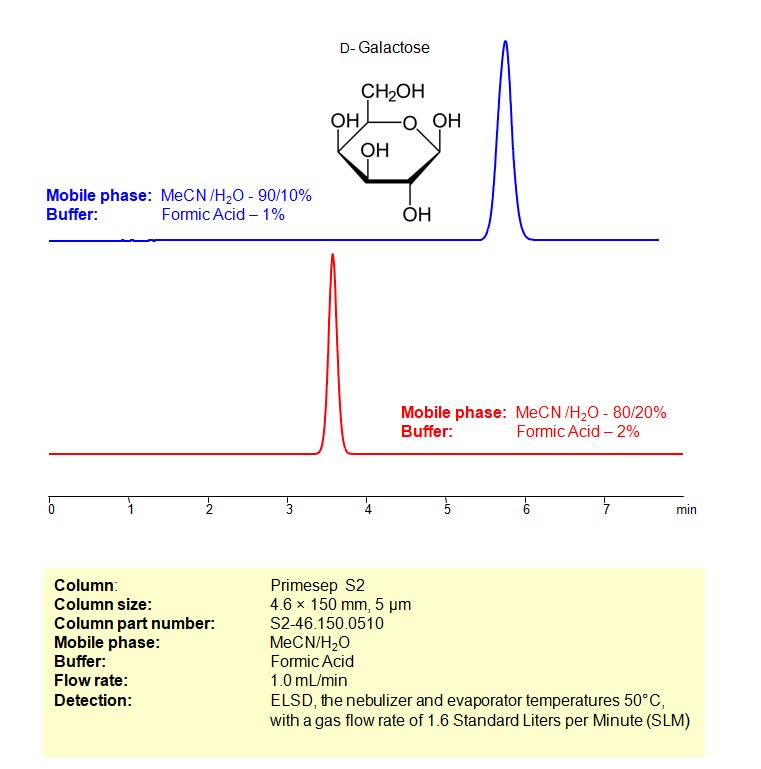HPLC Method for Analysis of D-Galactose on Primesep S2 by SIELC Technologies

High Performance Liquid Chromatography (HPLC) Method for Analysis of D-Galactose
Galactose is a monosaccharide sugar that plays a crucial role in the biochemistry of living organisms. It is one of the components of lactose, the sugar found in milk, and is thus commonly ingested in a diet that includes dairy products. Here’s more detailed information about galactose:
Basic Properties
- Molecular Formula: C6H12O6
- Structure: Galactose has a similar structure to glucose but differs in the configuration around one carbon atom. It’s a hexose, meaning it contains six carbons, and it has an aldehyde group, making it an aldose.
- Isomer: It has an optical isomer, D-galactose, which is the most commonly found isomer in nature.
Biological Role
- Lactose: Galactose is most commonly found in lactose, where it is bound to glucose. When you consume lactose, enzymes in your digestive system break it down into glucose and galactose.
- Glycoproteins and Glycolipids: Galactose is a component of various glycoproteins and glycolipids, which are important for cellular recognition and communication.
- Energy Source: After absorption, galactose is transported to the liver, where it is converted into glucose and used as an energy source.
Health Implications
- Galactosemia: As mentioned earlier, a lack of ability to metabolize galactose can lead to this genetic disorder, which requires dietary management.
- Cataract Formation: In certain cases, high levels of galactose can contribute to cataract formation in the eyes.
Galactose is vital in various biological processes and also presents a unique set of challenges due to its role in metabolic disorders like galactosemia. Understanding its biochemistry and metabolic pathways has implications in healthcare, dietetics, and even biotechnological applications.
Galactose can be retained, and analyzed on a Primesep S2 mixed-mode stationary phase column using an isocratic analytical method with a simple mobile phase of water, Acetonitrile (MeCN), and a formic acid as a buffer. This analytical method can be detected with high resolution and peak symmetry with many evaporative detection methods, including Evaporative Light Scattering Detection (ELSD), Charged Aerosol Detector (CAD), and Electrospray Ionization (ESI) for Mass Spectrometry (MS).
| Column | Primesep S2, 4.6 x 150 mm, 5 µm, 100 A, dual ended |
| Mobile Phase | MeCN/H2O |
| Buffer | Formic Acid |
| Flow Rate | 1.0 ml/min |
| Detection | ELSD, the nebulizer and evaporator temperatures 50°C, with a gas flow rate of 1.6 Standard Liters per Minute (SLM) |
| LOD* | 0.5 ppm |
| Class of Compounds | Sugar |
| Analyzing Compounds | D-Galactose |
Application Column
Primesep S2
Column Diameter: 4.6 mm
Column Length: 150 mm
Particle Size: 5 µm
Pore Size: 100 A
Column options: dual ended





